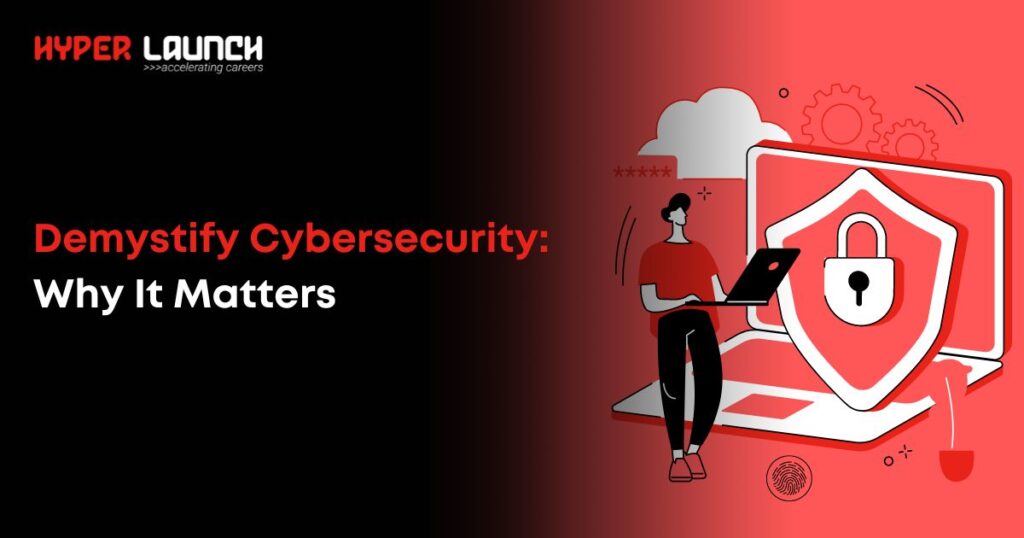Introduction to Cybersecurity
In today’s digital landscape, Cybersecurity has become a paramount concern for individuals, businesses, and governments alike. As we increasingly rely on technology to power our daily lives and operations, the need to safeguard our digital assets and information has never been more critical. In this comprehensive article, we will explore the fundamental aspects of cybersecurity, its importance, and the various measures we can take to protect ourselves and our organizations.
Cybersecurity is the practice of protecting systems, networks, and data from unauthorised access, misuse, and disruption. It encompasses a wide range of strategies, technologies, and best practices designed to mitigate the ever-evolving threats posed by cyber criminals, hackers, and other malicious actors. By understanding the core principles of cybersecurity, we can better navigate the complex and ever-changing digital landscape, ensuring the security and resilience of our digital infrastructure.
Why is Cybersecurity Important?
In the modern era, our dependency on technology has deeply ingrained itself in every facet of our lives. From personal communication and financial transactions to critical infrastructure and national security, the digital realm is the backbone of our society. However, this dependency increases our vulnerability to cyber threats such as data breaches, ransomware attacks, and identity theft. The importance of cybersecurity cannot be overstated. Effective measures protect personal information and assets, and safeguard the integrity of businesses, governments, and essential services, preventing devastating consequences like financial losses, reputational damage, and system disruptions.
By investing in robust cybersecurity strategies, we can:
- Protect our personal and sensitive information from unauthorized access and misuse.
- Ensure the confidentiality, integrity, and availability of our digital assets and systems.
- Maintain the trust and confidence of our customers, stakeholders, and the general public.
- Comply with regulatory requirements and industry standards related to data protection and privacy.
- Mitigate the financial and operational impact of cyber incidents, such as data breaches and system disruptions.
- Contribute to the overall resilience and security of our digital ecosystem.
Ultimately, embracing cybersecurity as a fundamental component of our digital lives is not just a choice, but a necessity in the modern world.
Common Cyber Threats
As our reliance on technology continues to grow, so too do the threats posed by cyber criminals and malicious actors. Understanding the most common cyber threats is the first step in developing effective cybersecurity strategies.
- Data Breaches: The unauthorized access and theft of sensitive personal, financial, or business data.
- Malware: Malicious software designed to infiltrate, damage, or disrupt computer systems and networks.
- Phishing: The practice of using fraudulent emails or messages to trick individuals into revealing sensitive information or performing harmful actions.
- Ransomware: A type of malware that encrypts a victim’s data and holds it for ransom, demanding payment in exchange for the decryption key.
- Distributed Denial of Service (DDoS) Attacks: Attempts to overwhelm and disrupt the availability of a website or online service by flooding it with traffic from multiple sources.
- Social Engineering: The manipulation of individuals into divulging sensitive information or performing actions that compromise security.
- Advanced Persistent Threats (APTs): Sophisticated, targeted, and sustained cyber attacks aimed at gaining access to sensitive information or disrupting critical systems.
Understanding these common cyber threats is essential in developing robust cybersecurity strategies and implementing appropriate protective measures.
Types of Cybersecurity Measures
To combat the ever-evolving cyber threats, a multifaceted approach to cybersecurity is required. There are several key types of cybersecurity measures that individuals and organisations can implement to enhance their digital resilience:
- Access Control: Implementing robust authentication methods, such as strong passwords, multi-factor authentication, and biometric identification, to restrict access to sensitive systems and data.
- Network Security: Deploying firewalls, intrusion detection and prevention systems, and virtual private networks (VPNs) to monitor and secure network traffic.
- Data Encryption: Ensuring the confidentiality of sensitive information by encrypting data both at rest and in transit.
- Endpoint Protection: Installing antivirus, anti-malware, and endpoint detection and response (EDR) solutions to safeguard individual devices and the broader network.
- Incident Response and Disaster Recovery: Developing comprehensive plans and procedures to effectively respond to and recover from cyber incidents, minimising the impact on operations.
- Employee Training and Awareness: Educating employees on cybersecurity best practices, such as recognizing phishing attempts, safeguarding sensitive information, and reporting suspicious activities.
- Vulnerability Management: Regularly identifying, assessing, and addressing vulnerabilities in software, systems, and networks to prevent exploitation by cyber criminals.
By implementing a combination of these cybersecurity measures, individuals and organisations can significantly enhance their ability to prevent, detect, and respond to cyber threats.
The Role of Individuals in Cybersecurity
While cybersecurity may seem like a complex and daunting topic, individuals play a crucial role in maintaining a secure digital ecosystem. As end-users of technology, we all have a responsibility to adopt good cybersecurity practices and become active participants in the ongoing fight against cyber threats.
As individuals, we can contribute to stronger cybersecurity by:
- Practising Good Cyber Hygiene: Maintaining strong and unique passwords, enabling two-factor authentication, and keeping our devices and software up-to-date.
- Recognising and Avoiding Phishing Attempts: Being vigilant in identifying and avoiding suspicious emails, messages, and websites that may attempt to steal our personal information.
- Securing Our Home Networks: Ensuring our home Wi-Fi networks are protected with strong passwords and enabling the latest security features.
- Protecting Sensitive Information: Carefully handling and safeguarding our personal and financial data, both online and offline.
- Staying Informed: Regularly educating ourselves on the latest cybersecurity threats and best practices, and being proactive in reporting any suspicious activities.
By embracing these individual responsibilities, we can collectively strengthen the overall cybersecurity posture and contribute to the resilience of our digital society.
The Role of Businesses in Cybersecurity
Businesses, regardless of their size or industry, are prime targets for cyber attacks due to the sensitive data and critical systems they manage. As such, the role of businesses in cybersecurity is paramount, as they have a responsibility to protect their assets, maintain the trust of their customers, and ensure the continuity of their operations.
Businesses can play a crucial role in enhancing cybersecurity by:
- Implementing Robust Security Measures: Deploying a comprehensive suite of cybersecurity tools and technologies, such as firewalls, antivirus software, and encryption, to safeguard their digital infrastructure.
- Developing Comprehensive Policies and Procedures: Establishing clear and well-documented policies and procedures to guide employee behaviour, incident response, and data management.
- Providing Cybersecurity Training: Educating and empowering employees to become the first line of defence against cyber threats through regular training and awareness programs.
- Conducting Regular Risk Assessments: Regularly evaluating and addressing the potential vulnerabilities and risks within their systems and networks.
- Collaborating with Industry and Authorities: Actively engaging with industry associations, cybersecurity experts, and government agencies to stay informed about the latest threats and best practices.
- Investing in Incident Response and Business Continuity: Developing and regularly testing comprehensive plans to respond to and recover from cyber incidents, ensuring business continuity and resilience.
By taking a proactive and holistic approach to cybersecurity, businesses can not only protect themselves but also contribute to the overall security and resilience of the digital ecosystem.
Government and Cybersecurity
Governments around the world play a crucial role in shaping and enforcing cybersecurity policies, regulations, and initiatives. As the custodians of critical infrastructure and national security, governments have a responsibility to lead the charge in securing the digital landscape.
Governments can contribute to cybersecurity in the following ways:
- Developing Robust Cybersecurity Policies and Regulations: Enacting laws, regulations, and guidelines to establish minimum security standards and hold organisations and individuals accountable for their cybersecurity practices.
- Investing in Cybersecurity Research and Development: Funding and supporting the development of innovative cybersecurity technologies, tools, and strategies to stay ahead of evolving threats.
- Coordinating Incident Response and Information Sharing: Facilitating the coordination of cybersecurity incident response efforts and the exchange of threat intelligence among various stakeholders, including the private sector and international partners.
- Providing Cybersecurity Education and Awareness Programs: Launching nationwide campaigns and initiatives to educate the public and private sectors on cybersecurity best practices and the importance of digital hygiene.
- Strengthening Critical Infrastructure Protection: Ensuring the security and resilience of essential services, such as power grids, transportation systems, and communication networks, against cyber threats.
- Fostering International Cooperation: Collaborating with other nations and international organisations to develop global cybersecurity frameworks, harmonise policies, and address transnational cyber threats.
By taking a proactive and collaborative approach to cybersecurity, governments can play a pivotal role in safeguarding the digital future of their citizens and the global community.
Cybersecurity Best Practices
Maintaining robust cybersecurity requires a combination of technical, organisational, and behavioural best practices. Here are some key cybersecurity best practices that individuals and organisations should consider:
- Implement Strong Access Controls: Enforce the use of complex, unique passwords, enable multi-factor authentication, and regularly review and update access privileges.
- Keep Software and Systems Up-to-Date: Ensure that all devices, applications, and operating systems are promptly updated with the latest security patches and bug fixes.
- Backup Data Regularly: Implement a comprehensive backup strategy to protect against data loss, ransomware, and other types of cyber incidents.
- Educate and Train Employees: Provide ongoing cybersecurity awareness training to help employees identify and respond to potential threats, such as phishing attempts and social engineering attacks.
- Establish Incident Response and Business Continuity Plans: Develop and regularly test comprehensive plans to effectively respond to and recover from cyber incidents, minimising the impact on operations.
- Conduct Regular Risk Assessments: Regularly assess the potential vulnerabilities and risks within your systems and networks, and implement appropriate mitigation strategies.
- Implement Network Segmentation and Monitoring: Divide your network into smaller, isolated segments to limit the spread of threats and enhance visibility into network activity.
- Encrypt Sensitive Data: Ensure the confidentiality of sensitive information by encrypting data both at rest and in transit.
- Partner with Cybersecurity Experts: Collaborate with reputable cybersecurity service providers and consultants to enhance your security posture and stay informed about the latest threats and best practices.
- Foster a Culture of Cybersecurity: Encourage a company-wide culture of cybersecurity awareness and responsibility, where everyone understands their role in protecting the organisation’s digital assets.
By consistently following these cybersecurity best practices, individuals and organisations can significantly reduce their risk of falling victim to cyber attacks and safeguard their digital assets.
Conclusion
In the ever-evolving digital landscape, cybersecurity has become a critical concern for individuals, businesses, and governments alike. By understanding the fundamental principles of cybersecurity and the various measures available to protect our digital assets, we can collectively strengthen the resilience of our digital ecosystem.
As we continue to navigate the complexities of the digital world, it is essential to remain vigilant, adopt good cyber hygiene practices, and collaborate with industry experts and authorities to stay informed about the latest threats and best practices. By embracing a comprehensive and proactive approach to cybersecurity, we can safeguard our personal information, safeguard our businesses, and contribute to the overall security and prosperity of our digital future.
In today’s digital world, cybersecurity threats are constantly on the rise. This creates a booming demand for skilled cybersecurity professionals. The Hyper Launch cybersecurity course offers a structured and accelerated path to equip you with the critical knowledge and hands-on experience to combat these threats. By mastering essential cybersecurity skills, continuously honing your expertise, and engaging with the cybersecurity community, you can position yourself for a fulfilling and secure career in this ever-growing field.



